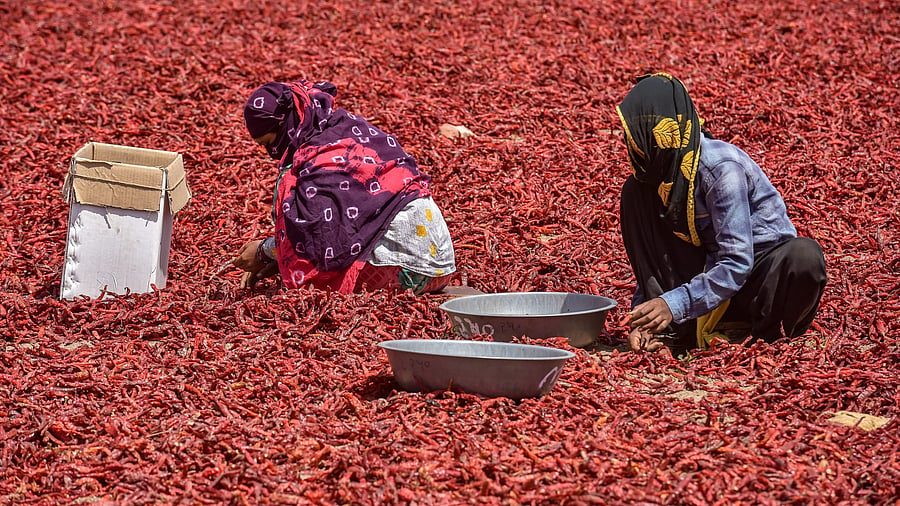
Workers remove stalks from chilli peppers at a farm.
Credit: PTI File Photo
Hyderabad: Market intervention by the government to support chilli farmers has thrown up an interesting outcome. Even before implementation, chili prices—representing one of India's important spice crops—have begun to rise. Now, farmers are requesting the government delay the intervention until prices stabilize at higher levels, concerned that implementing price stabilization could cap prices and prevent further increases. Andhra Pradesh, Telangana and Karnataka account for 3/4th of India's total chilli production.
Besides, Andhra Pradesh stands as India's largest chilli producer. Farmers in districts in Andhra Pradesh like Guntur, Prakasam, Kurnool, and Krishna grow numerous varieties, including Teja, Byadgi, DD Best, 341, 273, and 334, which attract significant international demand. The Guntur chili market, Asia's largest, sets domestic and global chili price trends. In 2023-24, chili constituted 39% of India's total spice exports. Red chilies represent a major horticulture crop in India's spice category, with the country leading global production while being the largest consumer and exporter. Among all spices, chili dominates in both quantity and value.
Red chilli prices in Andhra Pradesh had plummeted from highs of Rs 28,000 per quintal last year to below Rs 7,000 per quintal this season. Following pressure from N Chandrababu Naidu's government, the Union government intervened last month to provide financial support to farmers through a market intervention scheme.
Andhra Pradesh Chief Minister N Chandrababu Naidu personally visited Krishi Bhavan with Union ministers from the state last month to discuss the plight of chili farmers. Union Agriculture Minister Shivraj Singh Chouhan, unavailable at Krishi Bhavan, participated in the meeting with Naidu via video link.
On February 22, the Centre sanctioned a market intervention scheme (MIS) for 25% of the chilli quantity at Rs 11,781 per quintal. After this sanction order, the Andhra Pradesh government consulted stakeholders including farmers, agriculturists, and traders regarding implementation.
“Farmers indicated that prices have begun stabilizing since the MIS announcement. With prices trending upward, market participants requested that intervention be kept in abeyance until prices rise further and stabilize. Implementing price stabilization could cap prices at Rs 11,781 per quintal and prevent additional increases,” a senior Andhra Pradesh government official told DH.
Currently, data shows that prices across all variants have increased between Rs 500 and Rs 1,000 per quintal, providing farmers with break-even returns and much-needed relief.
“Data from the independent 'Agriwatch' agency shows the Teja variant price has risen to Rs 14,000. This demonstrates another example of the responsive Andhra Pradesh government providing timely relief to the chili sector,” the senior official added.